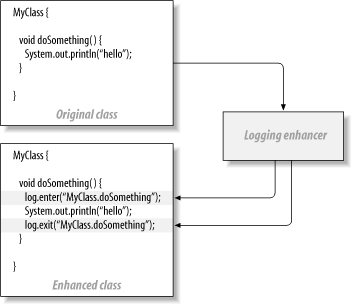4.5 Injecting Code
| To get better transparency, you can always automatically generate code and add it to the model. To date, most frameworks use this approach. Of course, since most Java developers use Ant to build their projects, adding a simple code enhancer to your applications is relatively easy to do with little intrusion on your build process. You can use code enhancement in two ways:
Often, when you inject code, you're actually injecting methods that perform the work of your intended service, as with the source code enhancer in Figure 4-6. Source code enhancement takes a class as an input and then generates code, typically method calls, to inject service capabilities into code, completely preserving transparency in the original class. Figure 4-6. This source code enhancer addslogging to MyClass JDO enhancers work this way: you create a class that's transparent with respect to persistence. The job of the JDO enhancer is to implement the PersistenceCapible interface. In order to make the class persistent, let your build process run it through a JDO enhancer. (Some of these use source code enhancement but most use byte code enhancement.) The enhanced class then calls the JDO framework to actually implement persistence. Some aspect-oriented programming frameworks use byte code enhancement, as well. The technique has many benefits:
For the most part, source code injection works well for techniques that are easy to parse and inject with simple code. Tasks such as adding logging, instrumenting code for performance analysis, or intercepting method calls all work well with a simple code injector. 4.5.1 Byte code enhancement frameworksByte code enhancement is a little more difficult to pull off. You'll need a strong knowledge of compilers, the Java byte code specification, and finer issues like threading. For this reason, most people use byte code enhancement through other frameworks. Some developers frown on byte code enhancement. It's been my experience that fear of the unknown drives this attitude more than practical experience. Knowledgeable teams can and do build byte code enhancers for commercial applications. Still, some perceive disadvantages:
The framework you choose depends on the services you need. JDO uses code enhancement to add transparent persistence. Some tools that make understanding decompiled code more difficult, called obfuscators, also use byte code enhancement to help you protect your intellectual property. In addition, some AOP frameworks enhance byte code at runtime when they load classes. You'll probably wind up using byte code enhancement solely through one of these. |
EAN: 2147483647
Pages: 111